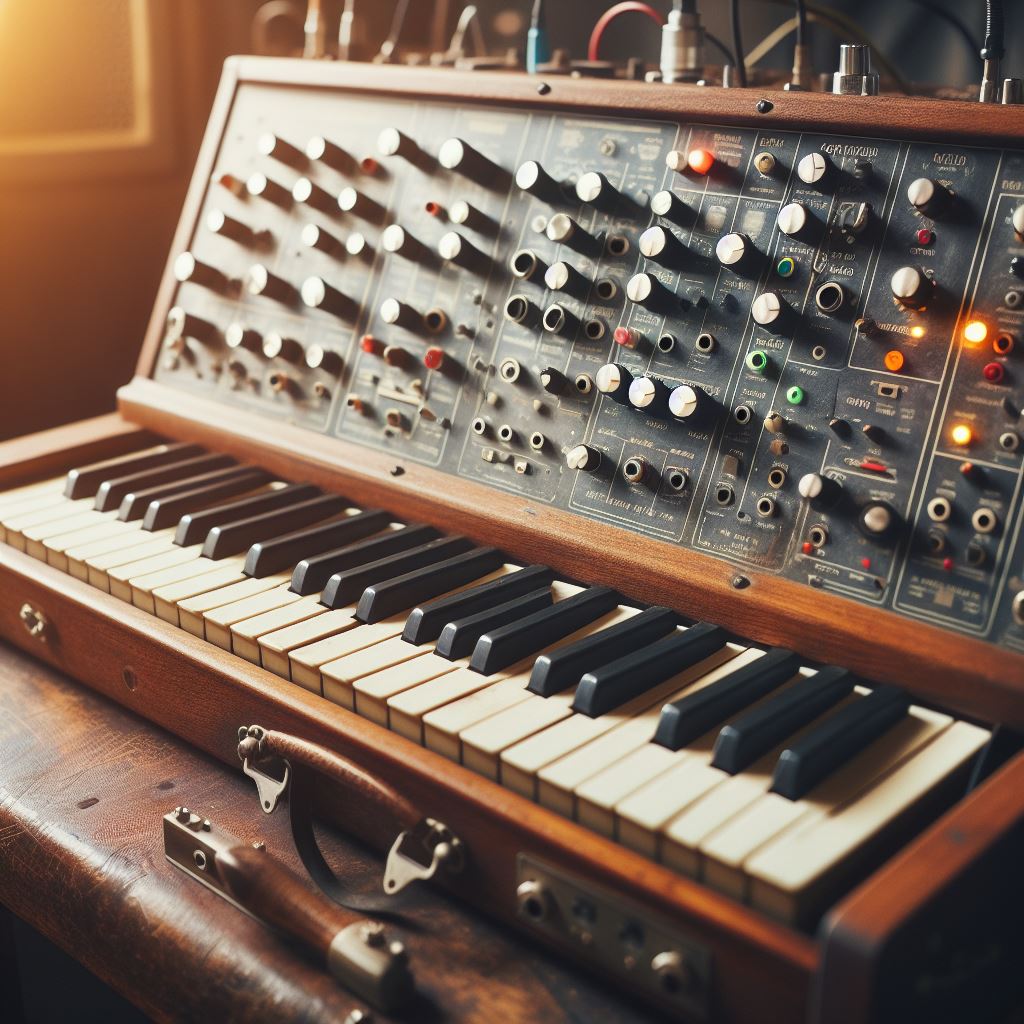A Very Brief Chronological History

1876: Elisha Gray, an American inventor, created the ‘Musical Telegraph’, which can be considered the first electronic musical instrument. This device used a piano keyboard in two octaves and a built-in speaker to reproduce sound.
1897: Thaddeus Cahill, another American inventor, created the ‘Telharmonium’, the first electro-musical polyphonic instrument. This device, which weighed over 200 tons, used rotary generators to create electrical signals that were then converted into sound.
Theremin’s Synthesizer (Thereminvox): This electronic musical instrument was created in 1920 by Soviet inventor Lev Sergeyevich Theremin. The Thereminvox is one of the few spatial musical instruments. It is a unique instrument that can be played without touching it.
1935: The appearance of the Hammond organ was an important step in the development of electronic musical instruments. This instrument used an electromechanical generator to create sound and was widely used in jazz, gospel music, and rock music.
ANS Synthesizer: This unique instrument was created by Soviet engineer Evgeny Murzin and is one of the first polyphonic musical synthesizers in the world. A working model of the ANS was completed in 1958. The ANS synthesizer is a photo-electronic optical musical instrument that uses the principle of the device based on the method of optical sound recording used in cinematography.
Late 1960s – early 1970s: During this time, the first analog synthesizers, such as Moog and ARP, appeared. These instruments used electronic oscillators to generate sound and allowed musicians to experiment with new sounds and timbres.
1980s: During this time, digital synthesizers, such as the Yamaha DX7, began to appear, which used digital signal processing to create sound. These instruments opened up new possibilities for creating and manipulating sound.
1990s and beyond: With the development of computer technology and software, virtual synthesizers appeared that allow musicians to create complex sounds and compositions right on their computers.
Today, synthesizers are an integral part of the music industry, used in many genres, from pop music to electronic music and film soundtracks. They continue to evolve and adapt to new technologies, opening up new possibilities for musical creativity.”
The history of synthesizers in a more detailed chronology. Information taken from website: 120 Years Of Electronic Music:
Pre 1800
1748: Denis D’Or
1759: Clavecin Électrique
1785: Clavecin Magnetique
1800 – 1900
1867: Electromechanical Piano
1876: Musical Telegraph
1897: Telharmonium
1899: Singing Arc
1900 – 1920
1905: Helmholtz Sound Synthesiser.
1909: Choralcelo
1915: Audion Piano
1912: Sound-Producing Device
1914: Wireless Organ
1918: Synthetic Tone
1920 – 1930
1921: Electrophon
1921: Hugoniot Organ
1922: Theremin
1923: Staccatone
1924: Sphäraphon
1925: The Luminaphone
1925: Radio Harmonium
1926: Pianorad
1926: Keyboard Electric Harmonium
1926: Kurbelsphärophon
1927: Dynaphone
1927: Cellulophone
1927: Piano Radioélectrique
1927: Electronde
1927: Robb Wave Organ
1927: Superpiano
1927: Neo Violena
1928: Ondes-Martenot
1929: Orgue des Ondes
1928: Klaviatursphäraphon
1929: Croix Sonore
1929: Hellertion & Heliophon
1930 – 1940
1930: Rhythmicon
1930: Ondium Péchadre
1930: Graphical Soundtrack
1930: Partiturophon
1930: Trautonium
1930: Hardy-Goldthwaite Organ
1930: Westinghouse Organ
1931: Nivotone
1930: Keyboard Theremin
1930: Magneton
1931: Radio Organ of a Trillion Tones,
Polytone Organ & Singing Keyboard
1931: Saraga-Generator
1932: Vibroexponator
1932: Variophone
1932: Emicon
1932: Rangertone Organ
1932: Terpsitone
1932: Gnome
1932: Electrone
1933: Sonar
1933: Electrochord & Kdf
Grösstonorgel
1934: Syntronic Organ & Photona
1934: Aetherwellengeige
1934: Singing Keyboard
1935: Hammond Organ
1935: The Jowiphon
1936: Sonothèque
1935: Marimbalite
1936: Welte Licht-Ton-Orgel
1936: Companola
1936: Mixturtrautonium
1937: Melodium
1937: Oscillon
1937: Warbo Formant Orgel
1937: Ekvodin
1939: Novachord
1939: Kaleidophon
1940 – 1950
1940: Ondioline
1940: Voder & Vocoder
1940: Solovox
1940: Univox
1943: Emiriton
1945: Hanert Electric Orchestra
1945: Thyratone
1945: Electronic Sackbut
1946: Minshall Organ
1946: Tuttivox
1946: Baldwin Organ
1947: Melochord
1948: Free Music Machine
1950–1960
1950: Electronium
1950: Lipp Pianoline
1951: Multimonica
1951: RCA Synthesiser I & II
1951: CSIR Mk1 & CSIRAC
1951: Dr Kent’s Electronic Music Box
1951: Chamberlin
1951: Ferranti Mk1
1951: Wobble Organ
1951: GRM
1951: WDR Electronic Music Studio
1952:Clavivox
1953: Composer-tron
1955: RAI Studio
1955: Fotosonor
1957: MUSIC N
1957: ANS Synthesiser
1958: Fonosynth
1959: Oramics
1959: Sound Processor
1959: Siemens Synthesiser
1959: Wurlitzer Side Man
1960–1970
1961: DIMI & Helsinki Electronic
Music Studio
1963: Mellotron & Novatron
1963: Akaphon
1963: Syn-ket
1964: Beauchamp Synthesise
1964: Moog Synthesisers
1965: Graphic 1
1966: Tubon
1966: Coupigny Synthesiser
1967: Stylophone
1967: MUSYS
1969: EMS Synthesisers
1970 – 1980
1970: Subharchord
1970: Archifooon
1970: Buchla Synthesisers
1970: ARP Synthesisers
1971: Allen Computer Organ
1971: Triadex Muse
1972: Qasar I,II & M8
1972: Motorola Scalatron
1976: Hal Alles Synthesiser
1977: Synclavier I & II
1977: Con Brio ADS
1977: Samson Box
1977: UPIC system
1977: DMX-1000
1979: Fairlight CMI
1980-1990
1981: Sogitec 4X
1981: Yamaha GS1& GS2
1981: Movement MCS drum computer
